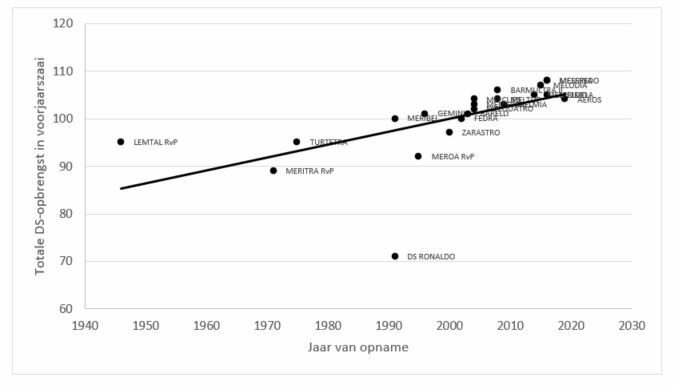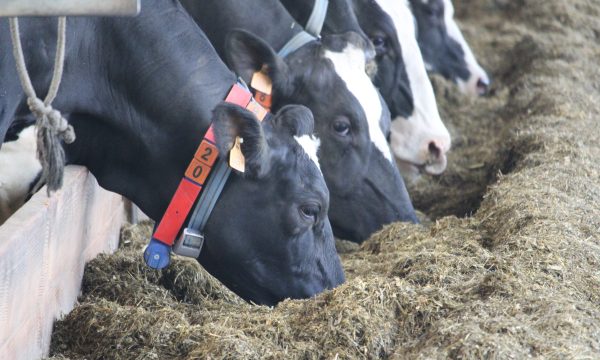Press release Exceptional ILVO trial proves that new varieties yield considerably more grass than old varieties

Dairy farmers can get up to 20% more grass (in dry matter) from their land by choosing new varieties. This is shown by an exceptionally large comparative variety trial of Italian ryegrass, carried out by Flanders Research Institute for Agriculture, Fisheries and Food (ILVO). Not only is the yield remarkably better, the grass of new varieties is also more digestible for the cows and more resistant to extreme weather conditions and to rust infection.
Variety testing expert Joke Pannecoucque: "This is a great proof of the success of grass breeding and important news for the dairy farmers. They can save up to 2 ha of grassland by making a well-considered variety choice".
Dairy farmer can save up to 2 ha of land through smart choice of grass varieties
Video about the new grass varieties list ((PlattelandsTV)
The new comparative list of Italian ryegrass varieties (2020) can now be consulted at Rassenlijst
Three factors determine grass yield: weather, fertilization and variety
Besides maize, grass is the most important crop on a dairy farm. A quarter of the ration of dairy cows consists of grass. But getting enough nutritious grass off the land is becoming increasingly difficult in practice due to extreme weather conditions and stricter fertilization standards. However, there is a third factor that determines the yield and feed value of grass: the variety choice. And that choice is in the hands of the dairy farmer.
Annual objective list of breeds helps farmers choose
To help farmers make the right choice, every year ILVO publishes a publicly available 'descriptive' list of varieties which compares the performance of some 20 varieties in objective tests. This is done annually, but this year the list is special. In 2018, ILVO exceptionally started a large trial in which ALL varieties registered on the Belgian list were sown and evaluated during two years.
Normally this does not happen because it takes (too) much space: only the new candidate varieties are sown and for the other varieties on the list an estimation of their performance is made by means of a statistical calculation. But since some varieties have been on the list for a very long time - the oldest variety since 1946! - it was time to compare their performance in practice with that of the younger varieties as well.
Exceptionally large trial: 22 breeds compared
A total of 22 breeds were compared in the large trial. Also two popular varieties from foreign lists were tested. These varieties are often sown by Belgian farmers, but have never been tested in Belgium before. All 22 varieties were scored for yield, persistence, rust resistance and digestibility. And the results are clear. Joke Pannecoucque: "In all respects, the newer varieties score better than the older ones. In addition, the varieties on the foreign list are also doing less well on a number of aspects than the varieties on our list".
(read more below the table)
In summary, the ILVO researchers draw the following conclusions from the variety table (see below):
1. New varieties yield more grass
New varieties have a higher yield potential, even in dry conditions such as in the 2018 and 2019 seasons. On an annual basis, the newest varieties yield 1.5 to 2 tons more dry matter per hectare. This means that only by choosing the best breeds, a dairy farmer with an average farm (± 25 ha of grassland) needs 2 ha less grassland to provide the cows in the barn with grass for a whole winter. These are 2 ha that can be used for other crops.

2. More kilos in the first cut
Many dairy farmers sow Italian ryegrass in the autumn to mow one cut in the spring, and then destroy the grass. Italian ryegrass as a species is particularly suitable for this purpose. It can't stand grazing very well and you can't leave it for years, but it does grow rapidly in spring. Still, here too the differences between the varieties are large. The varieties that yield above average in that first cut, are almost all younger than 10 years. This is a yield difference of up to almost 20%.
3. More persistent, more digestible and less susceptible to disease
Progress has also been made in the area of quality. The new varieties are more persistent, which means that fewer bald spots develop in the sod, even during the last dry seasons. New varieties also form fewer stems in the year of sowing, which improves the quality and digestibility of the harvested grass. Finally, new varieties are also more resistant to rust, resulting in a healthier crop.
Photo on the right: Difference in rust resistance.
4. Choose for varieties on the Belgian list
Finally, it appears that the two varieties tested in foreign catalogs (Italian and Polish) do not do as well as the varieties on the Belgian catalog on a number of aspects. Joke Pannecoucque: "Let this be a lesson: choose varieties on the Belgian variety list, because they are certain to perform well under Belgian growing conditions.
Objective figures for all forage crops
In summary, it pays for dairy farmers to look at ILVO's descriptive variety lists and make a choice based on them that best suits your own farm management. As an independent institute ILVO guarantees the objectivity of the results. All lists are easy to use and can be consulted free of charge on the website Home - Rassenlijst. Every year the results will be renewed so you will always find the most recent scores of all new varieties.
All breeding companies can have their varieties included in the comparative trials. This is not only done for Italian ryegrass, but for all forage crops. So also for other grasses, fodder beet, corn, etc. ILVO will soon plant the same exceptionally large variety trial as for English ryegrass. Companies can contact Joke Pannecoucque for more information.



